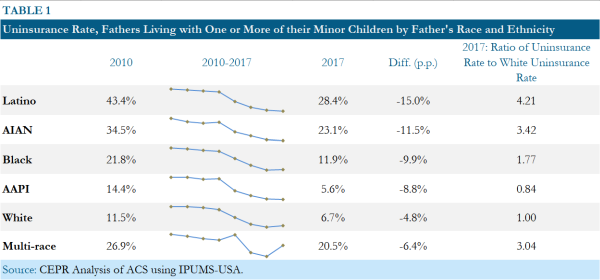June 13, 2019
The Affordable Care Act (ACA) led to increases in health insurance coverage and reductions in racial and ethnic disparities in coverage. With Fathers’ Day this weekend, it’s a good time to take a closer look at trends in coverage for fathers. In this post, we focus on fathers who report living with one or more of their minor children in the American Community Survey.
Overview
Following the passage of the ACA, uninsurance declined substantially among dads of all classes, races, and ethnicities. Yet large class, racial, and ethnic gaps in coverage remain. Some of the decline in dads’ uninsurance is due to the strong economy and the ACA’s private coverage-related provisions, but most of the credit goes to Medicaid and other public health insurance coverage. Despite this progress, far too many dads in our diverse working class remain uninsured, and the Trump administration is doing everything it can to undermine the health insurance system in ways that will reduce coverage and increase disparities. Ultimately, we need a universal Medicare plan that builds on the success of the ACA by providing comprehensive coverage to everyone, while creating a more efficient and simpler system.
Findings
Since the passage of the ACA, health insurance coverage among dads has increased. The uninsurance rate for dads fell from 19.1 percent in 2010 to 11.9 percent in 2017. About 1.8 million more dads had health insurance coverage in 2017 than in 2010. Still, about 3.4 million dads were uninsured in 2017.

Uninsurance is down among dads of all races and ethnicities, but most racial and ethnic disparities in coverage remain. As the table above shows, uninsurance declined for dads of all races and ethnicities between 2010 and 2017. Yet dads of color still have much higher uninsurance rates than white dads, with the exception of AAPI dads. Latino dads remain the largest group of uninsured dads (1.7 million uninsured), followed by white dads (1.2 million). Although not shown here, there are substantial differences in uninsurance rates within racial and ethnic groups. For example, Cuban and Puerto Rican dads have much lower uninsurance rates than Mexican-American and other Latino dads.
Uninsurance fell among working-class dads, but just over one-in-five remain uninsured. Among dads with more than 12 years of education, the uninsurance rate fell from 8 percent in 2008–2010 to 5 percent in 2015–2017. Dads with a high school education or less are much more likely to lack insurance, but their uninsurance rate did fall substantially — from 29 percent to 22 percent — over the same period.
The decline in dads’ uninsurance rate was driven in large part by increases in public coverage, particularly Medicaid. The number of dads with public coverage increased by just over 1 million between 2010 and 2017, with the vast majority of this increase attributable to Medicaid. By 2017, roughly one-in-eight dads — some 3.5 million — had coverage through Medicaid. In addition, about 500,000 more dads had employer-based coverage and about 300,000 more purchased individual coverage.
The uninsurance rate among dads fell substantially more in states that expanded Medicaid (as of 2017) than in states that did not. On average, state uninsurance rates for dads fell by 36 percent in the states that expanded Medicaid compared to a 21 percent decline in states that did not expand Medicaid. Most of the states that did not expand Medicaid are in the South, where blacks are a larger share of the population.
Among dads receiving public health insurance, most are in the labor force (75 percent in 2017). The share of dads receiving public coverage who are employed has steadily increased since 2010, mostly due to declines in unemployment and Medicaid expansion. In 2010, 56 percent of dads receiving public coverage were employed compared to 68 percent in 2017; over the same period, the unemployment rate of dads in public coverage fell by more than half, from 16 percent to 7 percent.
Most dads receiving public health coverage are married. People often associate Medicaid and other public programs with unmarried parents. But three-out-of-four dads receiving Medicaid or other public coverage are married. Since 2010, the number of married dads with public coverage has increased from 2.5 million to 3.3 million. Only one-in-seven dads enrolled in public coverage have never married.
Conclusion
Despite these positive trends, far too many people in the United States remain uninsured or underinsured, including millions of fathers. What dads and their kids really deserve for fathers’ day is Medicaid expansion in states that withheld it; an end to discriminatory barriers to coverage, like punitive Medicaid work requirements; and, Medicare for All.
Data, Methods and Limitations: All estimates in this post are from CEPR’s analysis of the American Community Survey using the IPUMS USA database at the University of Minnesota. Fathers are identified using IPUMS’ family-interrelationship variables and include fathers and adoptive fathers who are reported as living in the same household with one or more of their minor biological, step-, or adopted children. Among the limitations of this data source (and most other household surveys) is that it does not capture fathers who are not reported as residing with their children, even when they provide care and other support for these children. Among men who are parents of biological children under age 18 about 18 percent live with none of their children (although they may live with one or more step- or adoptive children). On nonresident fathers’ involvement with the children, see Fathers’ Involvement with their Children: United States, 2006-2010, Centers for Disease Control and Prevention.






